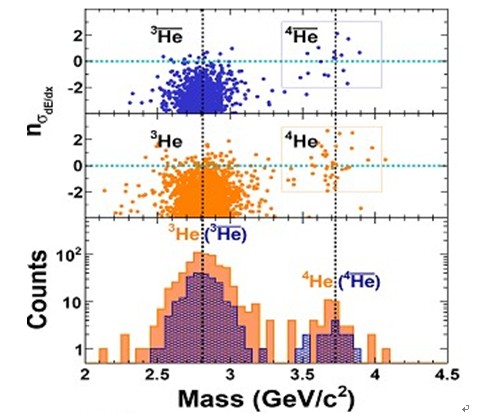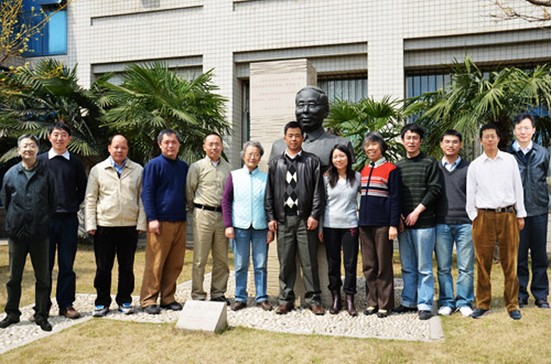The RHIC-STAR collaboration has recently detected the heaviest anti-matter nucleus – anti-Helium 4, also named anti-Alpha particle. This discovery has been published online on Nature in April 24th. It is highly possible that Anti-Helium 4 will be the heaviest anti-nuclei for a long time, since the possibility of producing the next heavier stable anti-nuclei is 10-6 of producing anti-Helium 4. The present accelerator technology can hardly achieve it.
The Relativistic Heavy Ion Collider (RHIC) at Brookhaven National Laboratory (BNL), located in Long Island of the United States, simulated the Big Bang with the collision of gold (Au) nuclei, creating a matter form similar to that of early universe. Most stable anti-matter nuclei, produced in the collision at RHIC will be detected by the STAR detector before annihilation. The STAR Collaboration has found 18 anti-Helium nuclei in about 500 billion charged particles produced from one billion Au+Au collision. This anti-nucleus is composed of two anti-protons and two anti-neutrons, in its stable bound state, and has two units of negative charge. Its mass is about four times of that of proton. Scientists have measured the production rate of anti-Helium 4, and found it is very close to the predicted result of quark coalescence model. It is an extremely exciting thing that human can catch such an anti-nucleus, composed of 12 quarks, in a matter lasting less than 1 trillions of a second, but with a temperature of 1 trillion degree.
Study on the production rate of anti-nucleus has great significance to new physics search in the universe. For example, the Alpha Magnetic Spectrometer (AMS), which will be launched in May 2011, will search anti-matter source in the universe. The outcome of STAR will provide a quantitative estimate of the background. The director of Office of Science, US Department of Energy, William F. Brinkman said, “This finding shows RHIC’s extraordinary ability in studying matter, anti-matter and the character of early universe”. According to the Big Bang theory, the amount of matter and anti-matter should be the same. The present universe composing of material remains a big mystery of physics. It will be meaningful to study this mystery if we can simulate the Big Bang and study anti-matter in the laboratory.

The Energy loss iof negatively charged particles (first panel) and positively charged particles (second panel) as a function of mass measured by the TOF system. The bottom panel shows a projection of entries in the upper two panels onto the mass axis. The combined measurements of energy loss and the time of flight allow a clean identification on 3He (anti-3He) and 4He (anti-4He) to be made in a sample of 0.5 × 1012 tracks from 109 Au+Au collisions.
The STAR Collaboration is composed of 54 institutions from 12 countries. Several institutions are from China, including Shanghai Institute of Applied Physics (SINAP), University of Science and Technology of China (USTC), Institute of Modern Physics (IMP), Tsinghua University (TSU), Central China Normal University (CCNU), and so on. The detector named “Time of Flight”, installed in STAR in 2009, partly supported by the National Natural Science Foundation of China (NNSFC), the Ministry of Science and Technology(MoST) and the Chinese Academy of Science (CAS) played a key role in indentifying the anti-He4. “In the discovery of anti-Helium 4 nucleus, the STAR-TOF detector is indispensible. Colleagues from USTC have made crucial contribution in the research and development, construction and data analysis of the TOF detector”, said Dr. Nu Xu, the STAR spokesperson.
The TOF team at USTC had received the funding from the National Natural Science Foundation of China, Chinese Academy of Science, Ministry of Science and Technology and USTC along the research work on STAR-TOF. The China-US Collaboration in developing TOF detector at STAR is a victory of international scientific cooperation.

Some STAR members took photo before the Statue of Mr. Zhao Zhongyao at USTC. Left to Right: Cheng Li(USTC), Ming Shao(USTC), Yi Wang(TSU), Feng Liu(CCNU), Nu Xu(LBNL/CCNU, the Spokesperson of STAR), Hongfang Chen(USTC), Yugang Ma(SINAP) , Lijuan Ruan(BNL), Xiaolian Wang(USTC), Yongjie Sun(USTC), Zebo Tang(USTC), Changbu Xu(BNL) and Huanzhong Huang(UCLA).
W020110705743219041536.jpg
